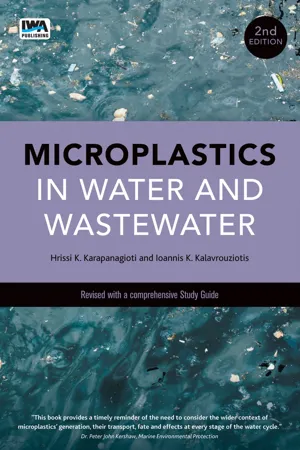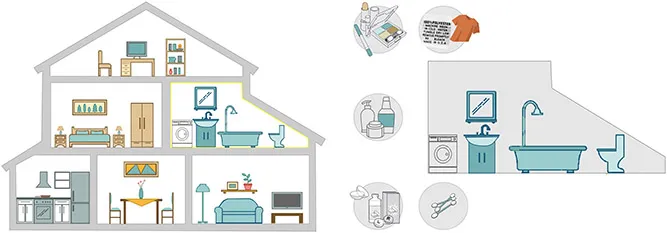![]()
© IWA Publishing 2020. Microplastics in Water and Wastewater Editors: Hrissi K. Karapanagioti and Ioannis K. Kalavrouziotis doi: 10.2166/9781789061697_0001
Chapter 1
Plastics and microplastics in the human water cycle
K. Katsanou1, H. K. Karapanagioti2 and I. K. Kalavrouziotis3
1University of Patras, Department of Geology, Patras, Greece
2University of Patras, Department of Chemistry, Patras, Greece
3Hellenic Open University, School of Science and Technology, Patras, Greece
Keywords: Drinking water, Fibers, Groundwater, Microbeads, Rivers, Wastewater, Water treatment
1.1 INTRODUCTION
The world is continually faced by the increased complexities of water pollution and its effects. For all water systems, plastics and microplastics, along with nanoplastics, are pollutants of emerging concern (Hernandez et al., 2017). In the past decades, there has been a boom in the use of plastic mainly due to its properties i.e., its durability and multipurpose utility, and it is likely that the amount of plastic will continue to steadily accumulate (Horton, 2017). The constant increase in synthetic plastic production and poor management in plastic waste have led to a tremendous increase in dumping into water bodies across the world (Raza & Khan, 2018).
The sources of microplastics are both land- and ocean-based (Hammer et al., 2012). Ocean-based sources represent only 20% of the total plastic debris in the marine environment (Andrady, 2011), whilst microplastics from land-based sources contribute the remaining 80% (Jambeck et al., 2015). Terrestrial sources come from many different origins but mainly from personal care products, air-blasting processes, improperly disposed plastics and leachates from landfill (Cole et al., 2011). Once terrestrial microplastics are released into water ecosystems, most of them are transported to oceans by rivers, while the rest remain in the freshwater environment (Browne et al., 2010; Li et al., 2018). Although microplastics are easily transported from the source once released into the environment, it has been found that their concentrations in sediments correlate with urbanization and human activity (Horton, 2017).
Up until recently, the plastic-derived pollution in the marine environment has been the focus and thus this topic is well studied. Although large plastics, to a certain extent, can be manually removed from the environment, most plastic pollution is mainly attributed to microplastics which are not easily removed. There is also the issue of “biodegradable” and “oxodegradable” plastics that are manufactured to contain chemical bonds that can be easily degraded (esters, ethers and amides). However, these polymers still have a non-degradable hydrocarbon base and the resultant pieces left are non-degradable fragments, i.e. microplastics (Shah et al., 2008). The only kinds of plastics that are totally degradable under natural conditions are bioplastics or compostable plastics (Horton, 2017).
While the vast majority of plastic sources are land-based, much less research has been focused on the investigation of their presence in freshwater ecosystems. Today, research has shifted towards inland waters. Modern studies are focused on the sources of microplastics, their pathways to marine environments, and the potential for microplastics to affect freshwater ecosystems and human health (Eerkes-Medrano et al., 2015).
This chapter is an attempt to characterize the presence, levels and potential implications of microplastics in freshwaters and wastewater, as well as identify the research gaps and future priorities. Given waste management deficiencies, microplastic pollution is an unknown component of possible impact and injury to our freshwaters and freshwater-dependent biological processes.
1.2 BASIC CHARACTERISTICS OF MICROPLASTICS
Plastics are complex polymer items produced with the addition of dyes and plasticizers, etc., which give them their specific properties i.e. flexibility, durability and heat resistance. The most commonly-used polymers – and most abundant in the environment – are polyethylene (PE), polypropylene, polyester, polyvinyl chloride (PVC) and nylon.
Microplastics are particles with all their dimensions being less than 5 mm (GESAMP, 2015). They are categorized into primary and secondary microplastics: primary microplastics are originally produced to be less than 5 mm in size, ranging down to 100 nm, while secondary microplastics result from the breakdown of larger items. They include particles of a wide range of types, shapes, color and sizes. Microplastic particles can be spherical beads, fragments, fibers or films and can be made of a variety of polymers. Particles less than 100 nm are classified as nanoplastics (Rios Mendoza et al., 2018).
Primary microplastics are those that are specifically manufactured to be of a small size for a specific application. They include pre-production pellets that are used in the plastic industry to manufacture larger plastic items and microbeads i.e. tiny spheres or granules added to products such as toothpastes and face scrubs for their exfoliating properties, and cosmetics for their light-reflecting properties (Browne, 2015; Cole et al., 2011). Secondary microplastics are derived by the breakdown of larger plastic items and are therefore a consequence of the degradation of manufactured products due to processes such as photo-degradation, and physical, chemical and biological interactions (Galgani et al., 2013; Thompson et al., 2009). Some examples are plastic fragments from litter degradation, tire debris, microfibers from textiles and degradation products from road-marking paints, fishing nets, household items and other discarded plastic debris (Eerkes-Medrano et al., 2015). Nanoplastics – manufactured either for research and medical purposes or formed by the degradation of microplastics – also pose an environmental threat (Koelmans et al., 2016).
As already mentioned, when plastic particles break down, they gain new physical and chemical properties, increasing their potential toxic effect on organisms. Microplastics may have a toxic effect on human health (particle, chemical and microbial hazards) or may be associated with chemicals either due to the addition of plasticizer chemicals during their manufacture or by adsorption of chemicals from the environment (Takada & Karapanagioti, 2019).
1.3 THE HUMAN WATER CYCLE
There is a daily water cycle that is associated with human water consumption in urban and suburban areas which includes: water collection from a water body, treatment, storage, distribution, house use which turns it into wastewater, and then wastewater collection, transportation, treatment and discharge into the same or another water body.
Drinking water sources include surface water (e.g. rivers, lakes or dams), groundwater (springs or wells) and seawater. It is collected and sent to a water treatment plant. According to the water source, the treatment plant includes various water treatment processes. Examples of the most common treatment processes for surface water include coagulation, flocculation, sedimentation, sand and coal filtration, aeration and disinfection. For groundwater they include hardness removal, aeration, metal chemical precipitation and disinfection, whilst for seawater they include coagulation, sand and coal filtration, ultrafiltration, reverse osmosis, pH and taste adjustment, and disinfection. After treatment, water is kept in big tanks and it is usually distributed to individual houses through water pipes using gravity. In the past, water pipes were made of clay, cement, or PVC; today, most water pipes are made of blue high-density PE (West, 2014).
Water uses in homes include drinking, washing dishes, washing clothes, personal hygiene, house cleaning, cooking and toilet flushing (see Figure 1.1). These activities turn drinking water into wastewater, including the addition of dissolved and particulate organic matter, suspended solids, microbes, dissolved salts that increase conductivity, nutrients, surfactants and micropollutants such as caffeine, antibiotics, cosmetics, pesticides and disinfectants, etc. Wastewater is collected from each house and, by gravity, it flows towards the nearby wastewater treatment plant (WWTP) using water pipes (West, 2014).
Figure 1.1Potential plastics and microplastics that can be released from a single house.
Municipal WWTPs are expected to lower the concentration of suspended solids and dissolved organic matter in the water. In some cases, nutrient and microbe removal is required by national or local regulations. Examples of the most common treatment processes include screening, coagulation, flocculation, sedimentation, disinfection, aeration and biological treatment (through one of the following: activated sludge, biological filters, membrane biological reactors, or suspended biocarriers an...

